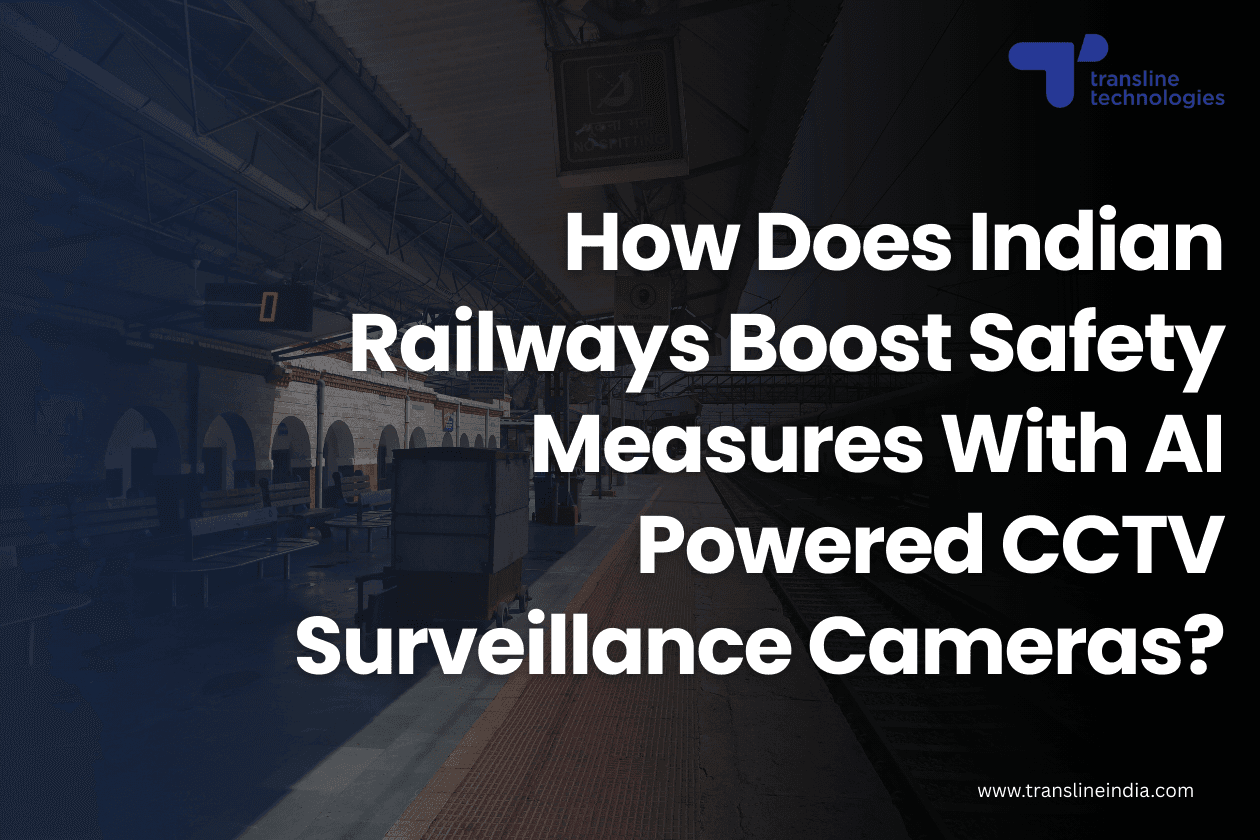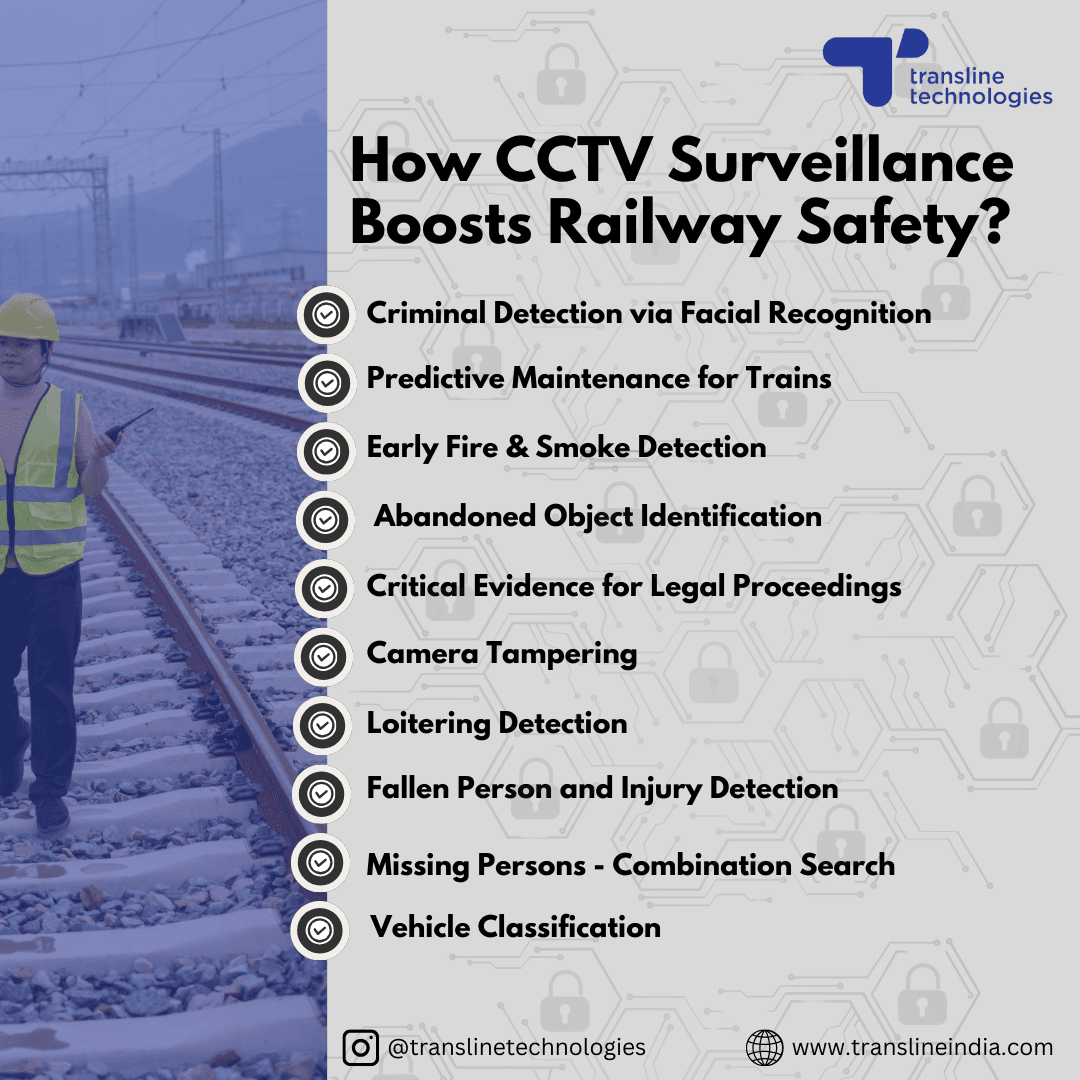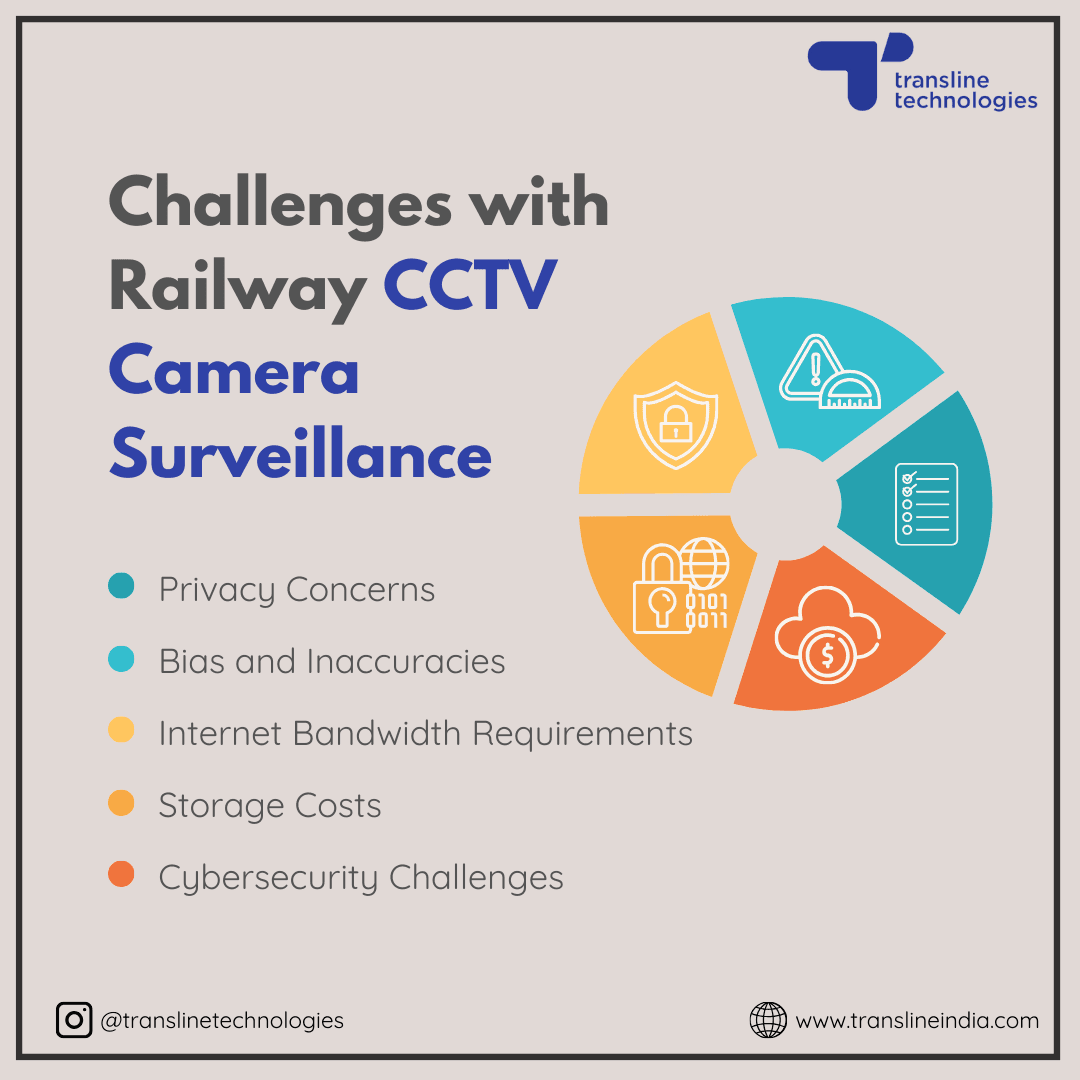
Why is Railways Safety Important?
The Indian Railways carried a total of 715 passengers over the financial year 2024-2025, according to reports, and the count has been growing consistently by about 5% CAGR in the post-pandemic period. Railway safety is vital for protecting the lives of the passengers, safeguarding assets of Indian Railways against accidents and theft, improving operational efficiency, building public trust, and adhering to regulatory compliance.
In this article, we shall discuss some of the key applications and challenges associated with implementation of CCTV camera in Indian Railways.
10 Ways in Which CCTV Surveillance Boosts Railway Safety
While railway CCTV cameras may have diverse applications, depending on the geographical terrain, location of the railway station and the administrative zone, we have jotted down some of the broad and generic ways in which railway CCTV surveillance boosts passenger safety, railway station safety, and employee safety.
Facial Recognition for Criminal Identification, Intrusion Detection and Access Management
AI-powered Railway CCTV cameras help identify notorious individuals and criminals who crime records exist in the database of police and law-enforcement agencies. Trains are often the preferred mode of travel for transnational criminals and hence the Railway Protection Force has been deploying facial recognition systems to identify miscreants from among the crowd in the railway station premises.
Facial Recognition is also employed in the railways as a means of recording biometric attendance and replaces the conventional fingerprint recognition and QR based attendance system, which suffer from lower effectiveness and higher chances of identity spoofing. Facial recognition using AI-powered railway CCTV cameras aid in access management to critical control rooms and power-supply stations, thereby ensuring that unauthorised persons cannot trespass into such protected zones.
Predictive Maintenance using AI Powered Railway CCTV Cameras
AI algorithms leverage existing railway CCTV infrastructure to monitor critical operational metrics of trains, and compare those with the theoretical threshold levels. In November 2024, the Howrah Division of Indian Railways started deploying AI and ML powered railway CCTV systems for predictive maintenance of Vande Bharat Express trains. As more and more data gets fed into the AI model, the accuracy of predicting the exact timing of maintenance improves.
Fire and Smoke Detection using AI Surveillance
AI railway CCTV systems detect early indicators of fire and arson, such as smoke, fumes, sparks, hidden flames etc. using Advanced Video Analytics and AI-ML algorithms. By using training data from CCTV systems with controlled conditions of fire, the AI model can detect any possible chance of fire and trigger real-time alerts to concerned officials for immediate action. AI CCTV based fire detection solutions work more effectively than traditional smoke detectors, have minimal downtime and also do not require installation of separate hardware.
Abandoned Object Detection using AI Railway Safety Cameras
Abandoned Objects are one of the highest security risks in railway stations because of the potential involvement of terrorists in planting explosives in such items. AI railway CCTV cameras leverage the power of Deep Embedded Vision to identify any abandoned or unclaimed object lying in the station premises beyond a certain period (usually 5 minutes or so), and also pinpoint its location, so that security personnel may recover it. This has another potential application in helping to recover lost luggage for passengers swiftly.
Critical Evidence Post Incident investigations
Railway CCTV Cameras capture and store video footage and hence provide critical evidence for legal purposes. CCTV Footage from any incident such as theft, damage of railway property and assets, causing inconvenience to others, attempts of arson and vandalism, terrorism attempts etc. is admissible in the Indian courts as valid evidence of crime and identification of criminals by the prosecution.

Camera Tampering Detection
As CCTV systems become ubiquitous in railway stations, incidents of camera tampering by miscreants have also become frequent. AI railway CCTV systems use multiple cues in the video frames, such as abnormal proximity of any person with the camera, sudden camera movement or change in orientation, to detect attempts of camera tampering. These systems can trigger real-time alerts of tampering incidents, thereby allowing railway security personnel to take prohibitory action.
Loitering Detection
Loitering in the platforms and overhead bridges for long periods is often perceived as a potential threat of pickpocket or other malicious activities. AI railway security systems help to readily flag such persons and send alerts to the Railway police officers for necessary action.
Fallen Person and Injury Detection
Passengers falling from the train, on escalators, or on platforms is a common scenario in railway stations. AI railway CCTV cameras can be trained to detect fallen persons and cases of injury to passengers with reasonable accuracy, and raise alerts to medical teams and railway security personnel. This helps security persons reach out to such victims rapidly and provide medical fast-aid and medical relief.
Missing Persons - Combination Search
AI-powered Video Analytics solutions can take identifiable human facial and other body attributes as inputs, and then scan video frames from railway CCTV cameras, to find missing persons and help them meet with their families or companions again. This technique is more effective against conventional public announcement systems, especially when searching for old, sick or physically challenged persons.
Vehicle Classification
Railway CCTV systems can classify the kind of vehicle entering the railway station premises based on identifiable parameters such as vehicle dimensions, front portion colour, speed of entry etc. This is vital information that is needed by railway security enforcement agencies to prevent accidents, route the vehicles to the right parking zones and prevent accidents within the railway premises.
Challenges with Railway CCTV Camera Surveillance
Despite the benefits of CCTV surveillance systems in ensuring railway protection, there are multiple challenges that are posed in the implementation of these railway security projects. We shall discuss some of these issue in brief here.
Privacy Concerns
Like other CCTV applications, installation of railways CCTV camera surveillance has also faced significant backlash from human rights activists.The concerns mostly rest around the infringement of privacy rights of passengers and discrimination by the AI model in identification of law-breakers.
Bias and Inaccuracies
The efficacy of railway CCTV systems has always been questioned due to multiple reasons. The AI facial recognition system may incorrectly identify genuine citizens as criminals if their facial features are somewhat in resemblance with the actual criminal’s image recorded in the database. The railway CCTV cameras may flag a piece of luggage as unclaimed if the passenger owning it is standing in close proximity to it but not actually holding it for a long time (this is in fact a frequent situation in railway retiring rooms).
Even for the fire-detection application, there may be multiple challenges – for example, when a routine welding task is being performed in the railway station premises, the AI railway CCTV system may trigger a false fire alarm due to the welding fumes and burning spatter detected in the footage.
Internet Bandwidth Requirements
The transmission of the railway CCTV camera video data from the railway stations to the central control room and servers usually involves significant Internet bandwidth requirements. Although the Indian Railways uses its proprietary OFC-based network connectivity, in remote railway stations, it may be a challenge to implement. The bandwidth requirements increase further when AI-based video analytics solutions are integrated with the conventional railway security systems.

Storage Costs
The more elaborate the surveillance coverage and the higher the video quality or resolution of the railway CCTV camera, the higher the storage requirements. While compression technologies like CAMSTORE employ advanced video compression algorithms to bring down CCTV camera storage costs, the ultimate storage costs can be arrived at only after considering the number of cameras whose footages are stored, the retention duration and the form of storage (cloud or on-premise).
Cybersecurity Challenges
Since railway CCTV systems capture, store and process sensitive data, they are prone to cyber attacks and data leaks. Hence the installation of CCTV cameras in Indian Railways has made it imperative to implement high standards of data security in parallel. Global data security standards have to be enforced in all railway CCTV data centers, switches and other points of connectivity where potential data breach may happen.
Transforming Railways Security with AI-powered CCTV Surveillance
Traditional CCTV cameras do capture railway activities but smart AI-powered CCTV surveillance not only monitors but smartly identifies gaps in operational functionalities and security measures. AI-driven software, when integrated with CCTVs, provides a comprehensive analysis of several activities, helping in identifying crimes, detecting potential hazards, preventing accidents and more.
At Transline Technologies, we have several years of expertise in installing CCTV cameras for Indian Railways. Some of our key projects include video surveillance at Western Railways (Kevadiya Railway Station, located 5 kilometers from the Statue of Unity), Northeast Frontier Railway (NFR), East Coast Railway (ECoR), and South East Central Railways (SECR). These projects have yielded significant results, improving passenger safety, enhancing overall railway security, and augmenting surveillance efficiency.
Delivering impactful results, we have provided solutions that not only ensures safety and security but also facilitates proper functioning of other operations like loitering detection, facial detection, intrusion detection and more. Detecting random suspicious objects, detecting object throws, and flagging any potential hazards not only prevents threats but also smartly secures public safety, building public trust.
Contact Us today to know more about how we help enhance Railways Security by improving railway employee safety and passenger safety simultaneously.



